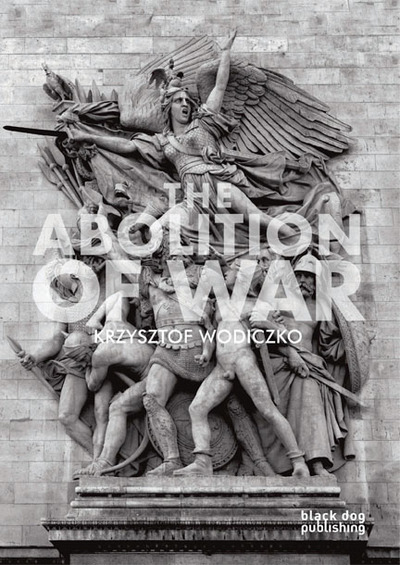A World without War?

The Abolition of War
Krzysztof Wodiczco
Black Dog Publishing
ISBN: 978-1-907317-668
144 pages, 35 illustrations, $24.95
The basic premise of Polish-born artist-activist Krzysztof Wodiczco’s book is that war memorials wrongly perpetuate the psychological belief that war has been and will always be unavoidable, and that the idea of service in war is a moral duty. Renowned for his large-scale interventionist projections on public monuments that critique cultural conflict, trauma, and memory, Wodiczco sets his sights on the Arc de Triomphe de l’Étoile in Paris as a major historical suspect and witness to the deadliest and most destructive military adventures in European history.
Built between 1806 and 1836 to pay tribute to Napoleon’s victories, the massive arch—160 feet high, 148 feet long and 72 feet wide—is the largest war memorial in Europe. The centrally located architectural monument also commemorates WWI (with an underground Tomb of the Unknown Soldier), and is described by Wodiczco as a legitimizing marker for subsequent wars in iconic, inscriptive, and architectural ways. In his manifesto-like latest book, Wodiczco describes his elaborate project to “un-war” the Arc de Triomphe, and transform it as the centerpiece for a World Institute for the Abolition of War.
Since his departure from Poland in 1977, disclosing and dismantling war-bound ideas and cultures has been Wodiczco’s artistic and educational mission. Shown in 2011 at the ICA, Boston, …OUT OF HERE: The Veterans Project, was an immersive sound environment based on chilling accounts of life during wartime in Iraq as told by affected medics, soldiers, and refugees.
In my telephone interview with Wodiczco, I was told that he has been concentrating on the Parisian war memorial for the past fifteen years. Since the Arc de Triomphe commemorates the first modern total war and the First World War with such monumentality, the artist told me, “I had to do something to change the cultural pedagogy of war promoted by its glorification of horrifying wars through a process of understanding, uncovering, and undoing war.” According to Wodiczco, the monument must be seen today as anachronistic in the new European Union, itself originally formed to prevent further wars on the continent as well as to promote economic prosperity.
Wodiczco’s brief but cogent Abolition of War is organized under the headings: “The Culture of War,” “The Arc de Triomphe: World Institute for the Abolition of War,” “Martyrology,” and “Abolition of War: An Agenda for Survival” (written by anthropologist Douglas Fry). Black-and-white photographs featuring bird’s-eye views and architectural and sculptural details of the Arc de Triomphe, including the 1918 Victory Parade, are scattered throughout. Particularly poignant is a photograph taken by the artist depicting uniformed boy scouts marching past “all key Warsaw war monuments, memorials, and sites of war suffering.” The frequently dense and passionate text is peppered with lists of all US military interventions since Wounded Knee, Global peace-building organizations, and other pages of pertinent anti-war quotes by the likes of author Victor Hugo, Nobel Peace Prize winner Joseph Rotblat, and philosopher Bertrand Russell.
In the section pertaining to artists and the culture of war, Wodiczco declares that war must be made illegal. Although he pays homage to artists from Goya to Walid Raad and William Kentridge who have questioned the assumptions surrounding war, Wodiczco claims that Western visual culture remains dominated by art that is either fascinated by war, emotionally distant from war, or silent about war. He then explains that his projects involving war memorials and monuments have been aimed at ridiculing the memorials’ moral authority, exposing their militarism, and revealing the contradictions between their lofty slogans and actual cruel outcomes.
Vivid descriptions as well as detailed drawings and scale models describe Wodiczco’s plan to immerse the Arc de Triomphe in a scaffolding-like structure containing ramps, lifts, mechanical platforms for displays of projections and interactive media environments intended to promote a war-free world. Plans for the World Institute for the Abolition of War include immersive displays and environments on global past and present peace-building efforts such as the UN. Parallel to the main frieze of the original structure would be a continuous strip of media-display panels showing all recorded wars, accompanied by lists of direct and indirect human casualties. Parallel to each of four massive sculptural reliefs, including François Rude’s iconic Departure of the Volunteers of 1792, would be listings of all killed and injured soldiers during Napoleonic campaigns. Above the roof are plans for a World Situation Map, reporting potential and existing wars, along with post-war and lasting peace zones. Eventually, the temporary scaffolding-like structure becomes dismantled and is replaced by an architectural structure to encase the Arc de Triomphe as “a curious relic of the never-returning again time of wars and war cultures.”
To date, the quantity of negotiations required to create and install the Arc de Triomphe: World Institute for the Abolition of War make its realization uncertain. Wodiczco has secured no governmental or legal permissions to encase the famed war monument in any kind of scaffolding. At present, only writings, drawings, and models related to his grand project have been realized. Whether or not Wodiczco is able to pull off such a utopian project on a grand scale, The Abolition of War offers convincing arguments for mobilizing a new society without war, a culture of un-war.
__________________________________________________________________________________________
Francine Koslow Miller, PhD is an art writer and the author of Cashing in on Culture: Betraying the Trust at the Rose Art Museum.
